Sheep for Meat: 10 Best Sheep Breeds for Meat
|
Are you interested in raising sheep for meat? The American Sheep 47 different sheep breeds in the US, with hundreds more recognized internationally. How do you decide which breed is right for your needs? Here is a list of the top 10 sheep breeds for meat. What sheep breeds are best for meat? There are many great options for meat-producing sheep. Here is a list of the top 11 sheep breeds for meat:
Dorper Sheep Dorset Sheep Katahdin Icelandic Sheep Barbados Blackbelly Hampshire Sheep Texel Sheep Tunis Sheep Cheviot Sheep ] Merino Best Sheep Breeds For Meat: Suffolk Sheep 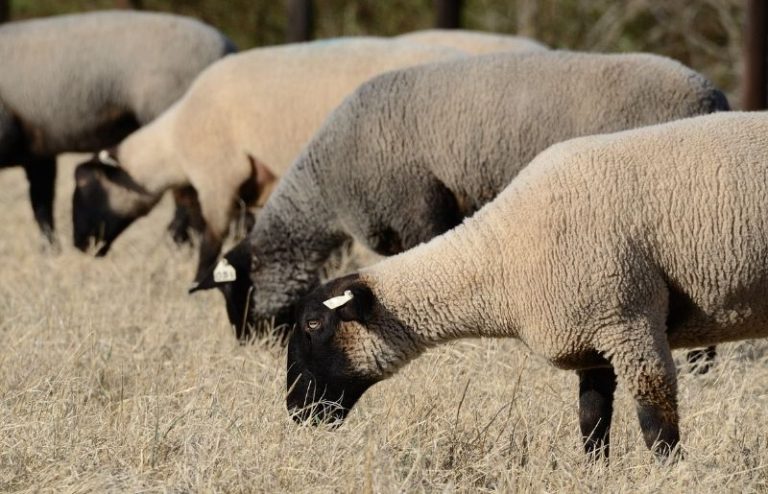 As one of the most populous sheep breeds in America, the Suffolk is a popular choice for meat producers. Suffolk ewes reach between 180-250 pounds, while rams can top out at 350 pounds. Reaching maturity earlier than many breeds, the Suffolk lamb will reach an average of 116 pounds by 100 days of age. Most lambs are considered market-ready by 9-12 weeks. Suffolk ewes are excellent mothers and prolific breeders. Mating season for Suffolk sheep usually happens in the Autumn or Winter of each year, as it is for most sheep breeds. Suffolk ewes have an excellent lambing rate of 180%, making them a solid choice for breeding. Suffolk meat is hailed as lean and somewhat sweet, with a good muscle to fat ratio. This breed tolerates both heat and cold – making them a good choice for most climates. Suffolk grow wool continuously, and will need to be sheared annually. Best Sheep Breeds For Meat: Dorper Sheep 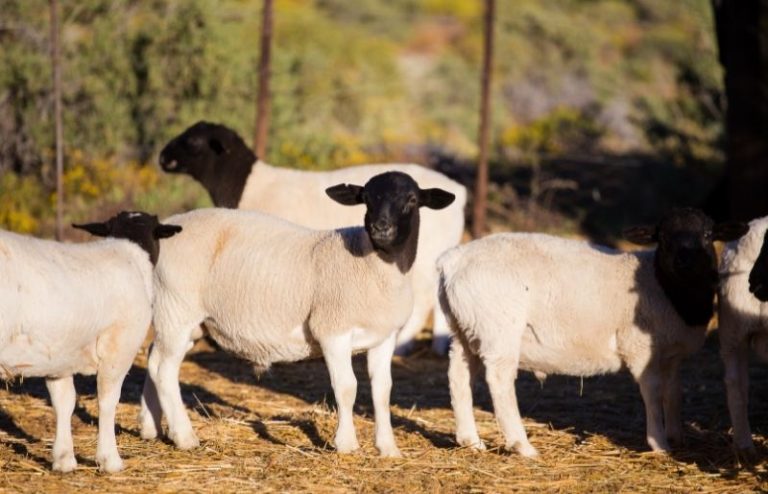 The Dorper sheep has gained popularity in the last decade for meat production, with ewes reaching a weight of 170-250 pounds, and rams up to 250 pounds. Dorpers are well-known to mature early as well, with most lambs considered market-ready in as little as 4 months old. A unique characteristic about the Dorper is that they do not breed seasonally, instead they are able to breed year-around. This means that, theoretically, a Dorper ewe can produce a lamb (or 2 or 3) every 8 months. Dorper sheep do well in warm, arid climates, but can tolerate cold as well. Dorpers grow a combination of hair and wool, and shed naturally – meaning no shearing is required. Because of their hair, they do not produce the lanolin that can lend gaminess to the meat, giving it a milder flavor. Best Sheep Breeds For Meat: Dorset Sheep 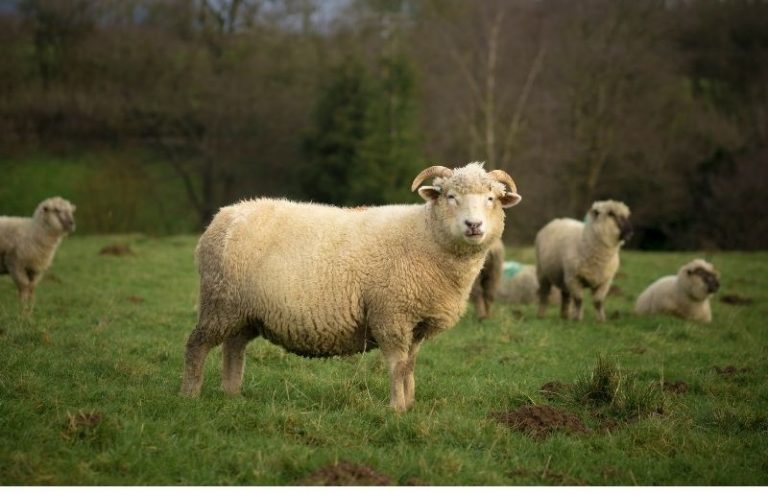 Considered to be the 2nd most popular breed of sheep in the US, the Dorset sheep is another solid meat-producer. Dorset ewes weigh approximately 150-200 pounds, with the rams weighing on average 275 pounds. Dorset lambs, like the Suffolk and Dorper, mature quickly and are market-ready earlier than many other breeds. Like the Dorper, Dorset ewes are able to breed year-round and are not limited to a typical Fall/Winter breeding season. Dorsets commonly produce twins and even triplets. Dorset sheep have lean and muscular carcasses, making them excellent at producing meat. Dorset sheep thrive in a wide variety of climates, and being wool-producers, they will need to be sheared annually. Best Sheep Breeds For Meat: Katahdin Sheep 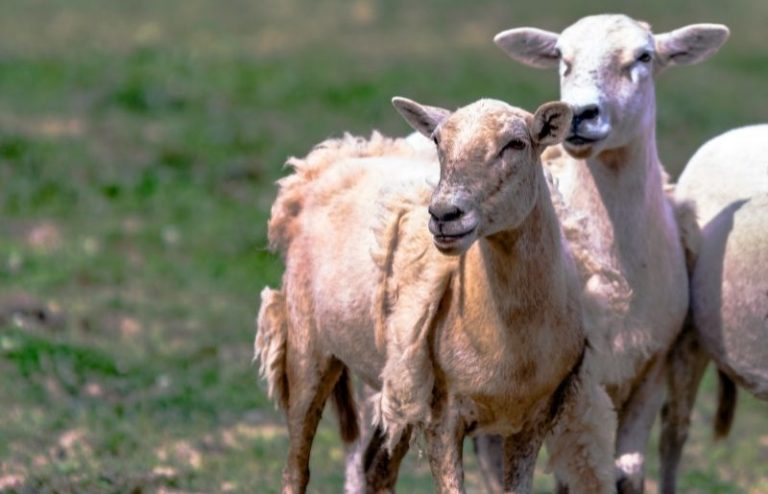 Katahdins are a popular meat breed for sheep farmers. Katahdin ewes weigh around 125-185 pounds, and rams average around 200 pounds. They grow quickly and reach market weight early. Katahdins often breeding out of season. Katahdins tend to birth twins, with triplets and quadruplets occurring often with good flock management. Katahdins are alert, protective mothers. They reach sexual maturity early, and will remain fertile for a longer period of time than many other breeds. Katahdin meat tends to be leaner than many other breeds. Katahdins have hair and not wool, which means they are a low-maintenance breed that will shed their hair naturally. Because of their hair, like the Dorper they do not produce lanolin which will give their meat a milder taste. This breed is adaptable and can live in many different climates. Best Sheep Breeds For Meat: Icelandic Sheep 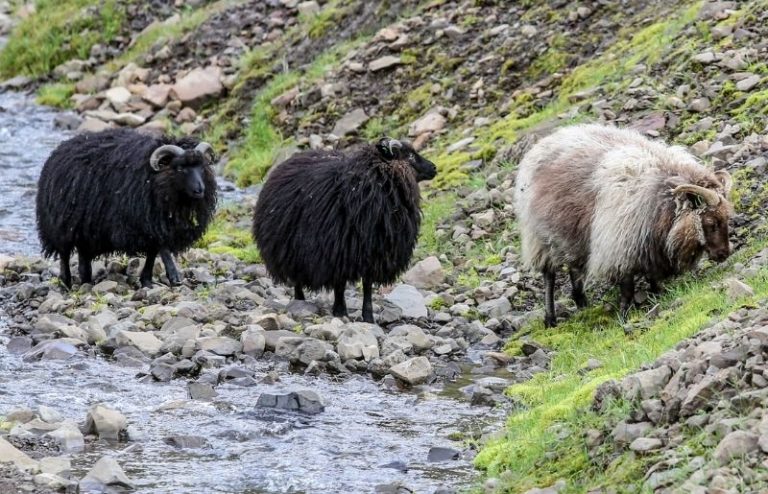 Icelandic Sheep are another popular choice for meat, with ewes weighing an average of 150 pounds at maturity, and rams averaging 200 pounds. Vigorous growers, the Icelandic produce lambs that are market-ready at 70-100 pounds in as little as 4-5 months. Icelandic Sheep are excellent and reliable breeders, breeding seasonally in the Fall to Winter. They reach sexual maturity very early, with ewes able to breed between 7 to 9 months of age. Being native to Iceland, this breed is exceptionally cold-hardy, and is an excellent and efficient forager – making it able to thrive and find food in harsh environments. Due to the high amount of red muscle fibers, the Icelandic sheep has a uniquely tender and fine texture. Though the breed produces wool (and lanolin), it is known to have a particularly mild taste. Because of the wool, the Icelandic sheep do need to be sheared once to twice per year. Best Sheep Breeds For Meat: Barbados Blackbelly 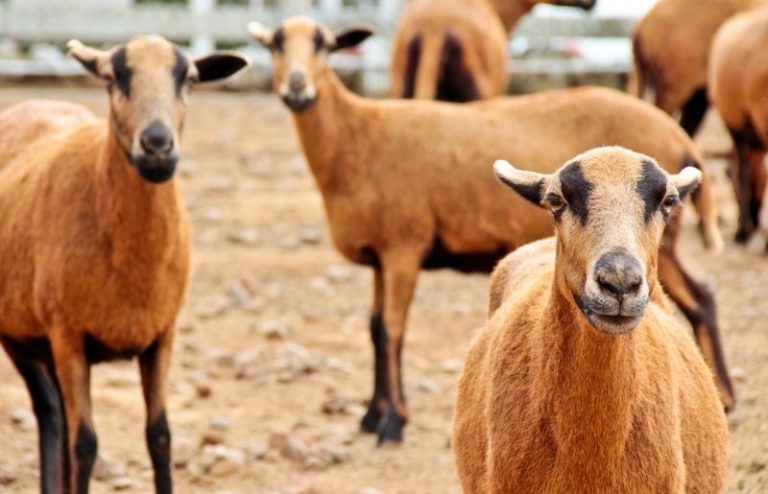 The Barbados Blackbelly got its name because of the characteristic black belly on an otherwise red brown coat. The Blackbelly is a smaller breed of sheep, with ewes maturing at around 100 pounds, and rams weighing on average 120 pounds. In addition to being a smaller breed, the lambs tend to mature slowly, not reaching ideal market weight until around 2 years of age. Though size and time to mature are not the Blackbelly’s strongest points, there are many advantages to raising this hardy breed of sheep. Blackbellys often breed easily and well, usually birthing multiple lambs in one breeding. They also are not limited to a breeding season, conceiving year round. Blackbelly’s have hair and not wool, making them a low-maintenance breed. They are also highly resistant to many parasites that can become bothersome to other breeds of sheep. Blackbelly’s are often left unvaccinated due to their disease and parasite resistance (though of course, we recommend you do your research on the breed and talk to a vet about what they recommend for vaccinating). Because of their hair and their low fat content, this breed is known to produce both flavorful and mild meat. This breed is also exceptionally hardy, able to thrive in both the cold, and the hot, humid climates in which many farmers struggle to raise sheep, making it a good choice for almost any climate in the United States. Best Sheep Breeds For Meat: Hampshire Sheep  Hampshire sheep have a muscular and stocky build, and are comparative to the Suffolk in size. Ewes weight approximately 200 pounds, and rams average out to around 260 pounds. Though large in size, Hampshire sheep tend to be a docile and easy-going breed. This breed produces rapid-growing lambs, with most lambs being considered ready for market at 12 weeks of age. While Hampshire sheep are seasonal breeders, they tend to have a longer breeding season than others. They are prolific breeders as well, often producing twins. Hampshire sheep can live in almost any climate, making them a hardy breed. They do produce wool, and will need to be shorn annually. Bred to produce less back fat, their meat is lean and flavorful. Best Sheep Breeds For Meat: Texel Sheep 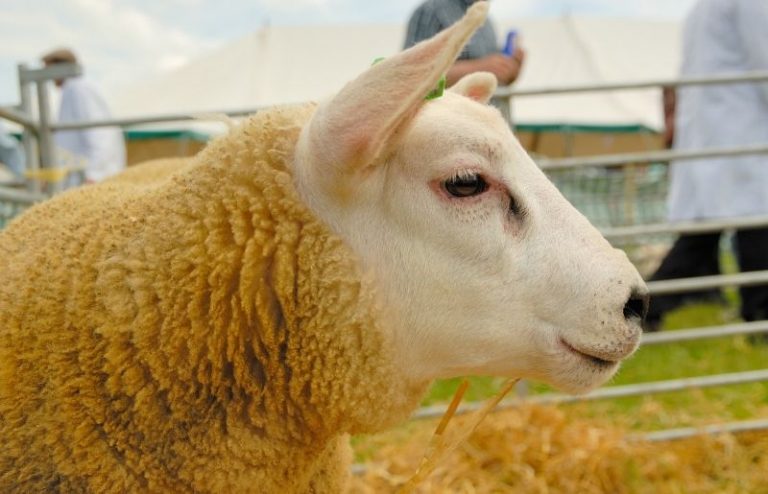 The bodybuilder of the sheep world, the Texel sheep is known for its heavily-muscled and sturdy frame. Ewes will weigh an average of 190 pounds, with rams reaching up to 300 pounds. Like most of the sheep listed here, Texel lambs reach market size quickly, by 5-6 months. With an extended breeding season of nearly 5 months, Texel sheep are prolific breeders. Ewes typically reach sexual maturity by 7 months. Texel sheep do best in colder climates, as they are exceptionally cold-hardy and have been known to be sensitive to the heat. They do produce wool, and will need regular shearing. Due to its heavily muscled carcass, the Texel sheep is a very popular meat breed. Best Sheep Breeds For Meat: Tunis Sheep 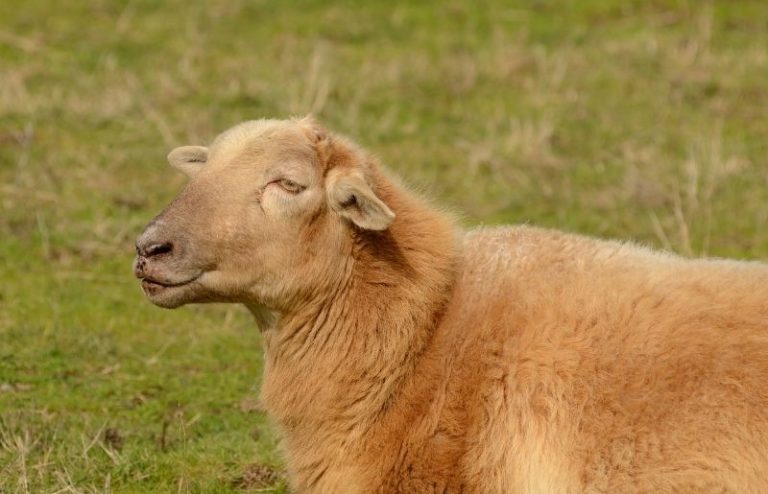 One of the oldest breeds of sheep, the Tunis is still a favorite breed for meat production. This breed averages in maturity at around 175 – 220 pounds. Lambs are efficient producers of meat. Though not year-round breeders, Tunis often breed out of season, with the occasional lamb (or two) born in late Summer / Fall. Tunis are solid breeders and excellent mothers. Tunis sheep are able to thrive in a variety of climates, and tolerate both heat and cold well. They do produce wool, and will need to be shorn annually. Tunis sheep are known to have an excellent flavor of meat. Best Sheep Breeds For Meat: Cheviot Sheep 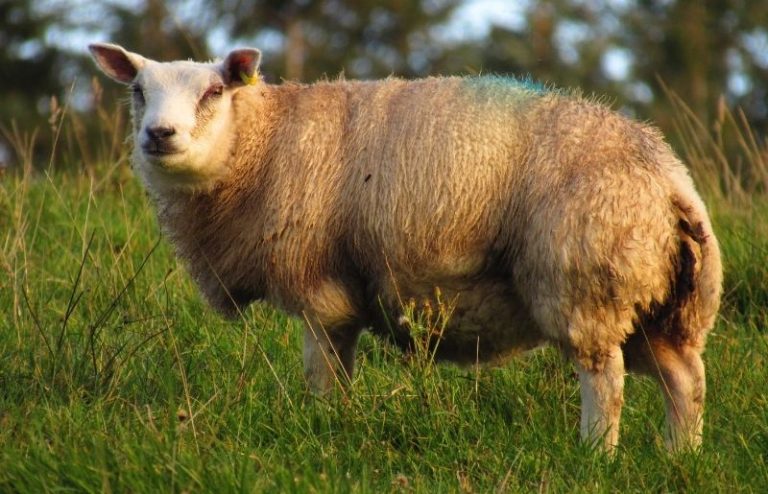 Last but not least on our list is the Cheviot breed. Average weight for the Cheviot is 130 – 175 pounds. Cheviots produce alert, strong lambs who are efficient foragers. Cheviots are easy to breed, meeting a 90% lambing average without assistance. They are seasonal breeders, conceiving in the Fall and Winter. The Cheviot sheep is best suited for northern, colder climates, and does not tolerate heat as well. They do produce wool, and need to be shorn on a regular basis. The carcass of the Cheviot tends to be plump and meaty, with just enough fat to produce a succulent meat. Merino 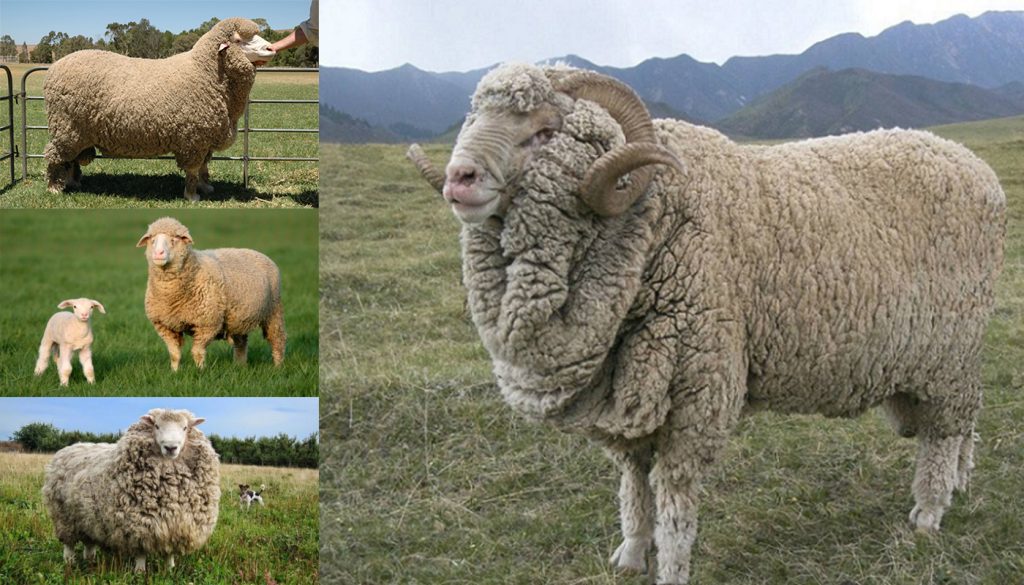 The Merino is a popular domestic sheep breed. Merino sheep are wool sheep breeds. However, they are also good for meat production. The Merino Sheep is not bred for its meat but rather it prized wool SHEEP ⇒ LAMB HOGGET/MUTTON Approx. Maturity Weight: 58 kgs 79 kgs What are Merino sheep characteristics? Merino sheep are medium sized animals with very beautiful appearance. They can be either polled or horned. The polled version has no horns, or has a very small stubs, known as scurs. And the horned version has long and spiral horns, which grow close to the head. What are Merino sheep known for? wool quality Merino is a type of breed which is known for its excellent wool quality. Its origins around founded in Spain near the beginning of the 12th century. Like all sheep, the Merino is descended from the Mouflon, wild sheep. Most of the world sheep population are wool producers. What is the lifespan of Merino sheep? 10 – 12 years Quick Facts about Merino Species Name: Ovis Aries Temperament: Meek Color Form: White Lifespan: 10 – 12 years Size: Medium Who bred the Merino sheep? Merino, breed of fine-wool sheep originating in Spain; it was known as early as the 12th century and may have been a Moorish importation. It was particularly well adapted to semiarid climates and to nomadic pasturing. What climate is best for merino sheep? MERINO SHEEP QUICK PROFILE OVERVIEW You may Also Like: 18 Best Wool Producing Sheep Breeds Can be used for Breed, **LSC, Wool, Temperament: Docile and easy to manage Ideal Climate: Heat, Cold, Most climates Which is better cashmere or Merino? Softer: Cashmere has a higher loft, which makes it softer. More Durable: Merino wool is sturdier and resists pilling more effectively. Easier to Care for: Merino generally requires less care in washing. Dressier: Cashmere is a more luxurious fabric with an elegant drape. Can you eat Merino sheep? Yes. What sheep breeds are used for wool? Merino. | The Merino is a superb forager and absolutely adaptable. Lincoln Sheep. | The Lincoln Sheep is also known as Lincoln Longwool, a breed of sheep from England. Dorset Sheep. Hampshire Sheep. Corriedale Sheep. Southdown Sheep. Columbia Sheep. Shropshire Sheep. What are the usual purposes for raising sheep? What are sheep? |
| How are sheep classified scientifically? |
|
What are ewes and rams? At what age do sheep start breeding? What should be the ratio of rams to ewes? What is mutton? What breed of sheep is good for mutton? How many total sheep are required per year to feed mutton to the people of the state? How much space is required to raise 1,000 sheep per year? What type of feed do sheep need? How much mutton is extracted from sheep more than one year old? How much mutton or equivalent consumable protein should a person consume per year? When should children be started on mutton? What is the difference between lamb and mutton? What type of sheep should you raise for mutton? Every state should establish sheep farms to be self-sufficient. Raising sheep should go ahead under the animal husbandry branch of state Agriculture and Food Sciences. Distribution should go ahead through state food and supplies. Food handlers should register with state food and supplies. There should be an equal quota for every person. How does mutton enhance the health of human beings? What type of cattle should you raise for beef? How does beef enhance the health of human beings? |
|
How long do sheep usually live? What's the difference between sheep and goats? What do sheep see, hear, and smell? Mostly sheep eat grass, clover, forbs, and other pasture plants. How much wool does a sheep produce? What are transgenic sheep? What do they do with sheep's blood? |
|
How are sheep raised? Who's involved in producing sheep? What challenges do sheep producers face? |
|
How many breeds of sheep are there? What are the housing needs of sheep? What's a simple way to provide shade for summer pasture rotation? How do you know how much to feed a sheep? How do you estimate the hay you need? Which is better, square bales or round, when buying hay? How do you determine what is good hay and what isn't? How good is good when it comes to hay? What about water? How do you keep water liquid in the winter? What is "flushing"? How do you "flush" the sheep? What is a breeding group? How do you know when to put the ram with the ewes? How long are ewes pregnant before they lamb? How long should the ram remain with the ewes? How can you tell when lambing will start? What do you do during lambing? What about after lambing? What about ear tags, selenium, etc? What medications are recommended to use on sheep? How do you give a sheep a shot? Hygiene Which products are covered by the hygiene rules? What are the HACCP principles? Do farm operators need to introduce HACCP? Who has the primary responsibility for hygiene and how is this verified? Who will develop the guides to good practice? How is traceability and marking guaranteed? Who is responsible for meat inspection? Is inspection of live animals possible on the farm? Inspection on the farm by an approved veterinarian is possible. How will meat inspection change with the new rules? What are the farmer’s obligations when sending animals for slaughter? What is the level of supervision in cutting plants? Is there flexibility for businesses or traditional products? Are there any exemptions from these hygiene rules? |
| Sheep Wool |
|
What are the usual purposes for raising sheep? Wool, meat, and milk. What are sheep? Sheep is a term for selective grazing animals that may be domesticated (tamed) or wild. Sheep are mammals with a thick woolly coat, kept in flocks and raised for meat, wool or milk. Some sheep have hairy coats and are called hair sheep. Sheep are ruminants, which means that they, like cattle and goats, chew their cud. Adult female sheep are called ewes, adult males are called rams and young sheep are called lambs. How are sheep classified scientifically? You should know scientific classification of sheep. In various regions, sheep are known by local names. What are ewes and rams? At what age do sheep start breeding? What should be the ratio of rams to ewes? What is mutton? What breed of sheep is good for mutton? How many total sheep are required per year to feed mutton to the people of the state? How much space is required to raise 1,000 sheep per year? What type of feed do sheep need? How much mutton is extracted from sheep more than one year old? How much mutton or equivalent consumable protein should a person consume per year? When should children be started on mutton? What is the difference between lamb and mutton? What type of sheep should you raise for mutton? Every state should establish sheep farms to be self-sufficient. Raising sheep should go ahead under the animal husbandry branch of state Agriculture and Food Sciences. Distribution should go ahead through state food and supplies. Food handlers should register with state food and supplies. There should be an equal quota for every person. How does mutton enhance the health of human beings? What type of cattle should you raise for beef? How does beef enhance the health of human beings? How many breeds of sheep are there? Worldwide, over 450. Take a look at this. What's a simple way to provide shade for summer pasture rotation? How do you know how much to feed a sheep? How do you estimate the hay you need? Which is better, square bales or round, when buying hay? How do you determine what is good hay and what isn't? How good is good when it comes to hay? What about water? How do you keep water liquid in the winter? What is "flushing"? How do you "flush" the sheep? What is a breeding group? How do you know when to put the ram with the ewes? How long are ewes pregnant before they lamb? How long should the ram remain with the ewes? How can you tell when lambing will start? What do you do during lambing? What about after lambing? What about ear tags, selenium, etc? What medications are recommended to use on sheep? How do you give a sheep a shot? Hygiene Which products are covered by the hygiene rules? What are the HACCP principles? Do farm operators need to introduce HACCP? Who has the primary responsibility for hygiene and how is this verified? Who will develop the guides to good practice? How is traceability and marking guaranteed? Who is responsible for meat inspection? Is inspection of live animals possible on the farm? Inspection on the farm by an approved veterinarian is possible. How will meat inspection change with the new rules? What are the farmer’s obligations when sending animals for slaughter? What is the level of supervision in cutting plants? Is there flexibility for businesses or traditional products? Are there any exemptions from these hygiene rules? | |
|
Sheep Domestic sheep A research flock at U.S. Sheep Experiment Station near Dubois, Idaho Conservation status Domesticated Scientific classification Kingdom: Animalia Phylum: Chordata Class: Mammalia Order: Artiodactyla Family: Bovidae Subfamily: Caprinae Genus: Ovis Species: O. aries Binomial name Ovis aries Linnaeus, 1758 Sheep (Ovis aries) are quadrupedal, ruminant mammals typically kept as livestock. Like all ruminants, sheep are members of the order Artiodactyla, the even-toed ungulates. Although the name "sheep" applies to many species in the genus Ovis, in everyday usage it almost always refers to Ovis aries. Numbering a little over one billion, domestic sheep are also the most numerous species of sheep. Sheep are most likely descended from the wild mouflon of Europe and Asia. One of the earliest animals to be domesticated for agricultural purposes, sheep are raised for fleece, meat (lamb, hogget or mutton) and milk. A sheep's wool is the most widely used animal fiber, and is usually harvested by shearing. Ovine meat is called lamb when from younger animals and mutton when from older ones. Sheep continue to be important for wool and meat today, and are also occasionally raised for pelts, as dairy animals, or as model organisms for science. Sheep husbandry is practised throughout the majority of the inhabited world, and has been fundamental to many civilizations. In the modern era, Australia, New Zealand, the southern and central South American nations, and the British Isles are most closely associated with sheep production. Sheep-raising has a large lexicon of unique terms which vary considerably by region and dialect. Use of the word sheep began in Middle English as a derivation of the Old English word scēap; it is both the singular and plural name for the animal. A group of sheep is called a flock, herd or mob. Adult female sheep are referred to as ewes, intact males as rams or occasionally tups, castrated males as wethers, and younger sheep as lambs. Many other specific terms for the various life stages of sheep exist, generally related to lambing, shearing, and age. Being a key animal in the history of farming, sheep have a deeply entrenched place in human culture, and find representation in much modern language and symbology. As livestock, sheep are most-often associated with pastoral, Arcadian imagery. Sheep figure in many mythologies—such as the Golden Fleece—and major religions, especially the Abrahamic traditions. In both ancient and modern religious ritual, sheep are used as sacrificial animals. Contents * 1 Description o 1.1 Breeds * 2 Diet * 3 Behavior and intelligence * 4 Reproduction * 5 Health o 5.1 Predation * 6 Economic importance * 7 As food * 8 In science * 9 Cultural impact o 9.1 In religion and folklore * 10 See also * 11 Footnotes * 12 References * 13 External links Life cycle Rams being taken to market Ewes are pregnant for just under five months before they lamb, and may have anywhere from one to three lambs per birth. Some ewes can have seven or eight lambs[citation needed]. Twin and single lambs are most common, triplets less common. A ewe may lamb once or twice a year. Lambs are weaned at three months. Sheep are full grown at two years and can weigh between 60 and 125 kilograms. Sheep can live to eleven or twelve years of age. Description A sheep's skull Domestic sheep are relatively small ruminants, usually with a crimped hair called wool and often with horns forming a lateral spiral. Domestic sheep differ from their wild relatives and ancestors in several respects, having become uniquely neotenic as a result of selective breeding by humans.[1][2] A few primitive breeds of sheep retain some of the characteristics of their wild cousins, such as short tails. Depending on breed, domestic sheep may have no horns at all (polled), or horns in both sexes (as in wild sheep), or in males only. Most horned breeds have a single pair, but a few breeds may have several.[3] Another trait unique to domestic sheep (as compared to wild ovines, not other livestock) is their wide variation in color. Wild sheep are largely variations of brown hues, and variation with species is extremely limited. Colors of domestic sheep range from pure white to dark chocolate brown and even spotted or piebald.[4][5] Selection for easily dyeable white fleeces began early in sheep domestication, and as white wool is a dominant trait it spread quickly. However, colored sheep do appear in many modern breeds, and may even appear as a recessive trait in white flocks.[4][5] While white wool is desirable for large commercial markets, there is a niche market for colored fleeces, mostly for handspinning.[6] The nature of the fleece varies widely among the breeds, from dense and highly crimped, to long and hair-like. There is variation of wool type and quality even among members of the same flock, so wool classing is a step in the commercial processing of the fibre. Suffolks are a medium wool, black-faced breed of meat sheep that make up 60% of the sheep population in the U.S.[7] Depending on breed, sheep show a range of heights and weights. Their rate of growth and mature weight is a heritable trait that is often selected for in breeding.[7] Ewes typically weigh between 45 and 100 kilograms (99 and 220 lb), and rams between 45 and 160 kilograms (99 and 350 lb).[8] Mature sheep have 32 teeth. As with other ruminants, the front teeth in the lower jaw bite against a hard, toothless pad in the upper jaw. These are used to pick off vegetation, then the rear teeth grind it before it is swallowed. There are eight lower front teeth in ruminants, but there is some disagreement as to whether these are eight incisors, or six incisors and two incisor-shaped canines. This means that the dental formula for sheep is either I:0/4 C:0/0 P:3/3 M:3/3, or I:0/3 C:0/1 P:3/3 M:3/3.[9] There is a large toothless gap between the front "biting" teeth and the rear "grinding" teeth. For the first few years of life it is possible to calculate the age of sheep from their front teeth, as a pair of milk teeth is replaced by larger adult teeth each year, the full set of eight adult front teeth being complete at about four years of age. The front teeth are then gradually lost as sheep age, making it harder for them to feed and hindering the health and productivity of the animal. For this reason, domestic sheep on normal pasture begin to slowly decline from four years on, and the average life expectancy of a sheep is 10 to 12 years, though some sheep may live as long as 20 years.[3][10][11] Sheep have good hearing, and are sensitive to noise when being handled.[12] Sheep have horizontal slit-shaped pupils, possessing excellent peripheral vision; with visual fields of approximately 270° to 320°, sheep can see behind themselves without turning their heads.[6][13] However, sheep have poor depth perception; shadows and dips in the ground may cause sheep to baulk. In general, sheep have a tendency to move out of the dark and into well-lit areas,[14] and prefer to move uphill when disturbed. Sheep also have an excellent sense of smell, and, like all species of their genus, have scent glands just in front of the eyes, and interdigitally on the feet. The purpose of these glands is uncertain,[15] but those on the face may be used in breeding behaviors.[7] The foot glands might also be related to reproduction,[7] but alternative reasons, such as secretion of a waste product or a scent marker to help lost sheep find their flock, have also been proposed.[15] Sheep and goats are closely related as both are in the subfamily Caprinae. However, they are separate species, so hybrids rarely occur, and are always infertile. A hybrid of a ewe and a buck (a male goat) is called a sheep-goat hybrid (only a single such animal has been confirmed), and is not to be confused with the genetic chimera called a geep. Visual differences between sheep and goats include the beard and divided upper lip unique to goats. Sheep tails also hang down, even when short or docked, while the short tails of goats are held upwards. Sheep breeds are also often naturally polled (either in both sexes or just in the female), while naturally polled goats are rare (though many are polled artificially). Males of the two species differ in that buck goats acquire a unique and strong odor during the rut, whereas rams do not.[11] Breeds Sheep being judged for adherence to their breed standard, and being held by the most common method of restraint See also: List of sheep breeds The domestic sheep is a multi-purpose animal, and the more than 200 breeds now in existence were created to serve these diverse purposes.[3][16] Some sources give a count of a thousand or more breeds,[17][18] but these numbers cannot be verified.[6][11] Almost all sheep are classified as being best suited to furnishing a certain product: wool, meat, milk, hides, or a combination in a dual-purpose breed. Other features used when classifying sheep include face color (generally white or black), tail length, presence or lack of horns, and the topography for which the breed has been developed. This last point is especially stressed in the UK, where breeds are described as either upland (hill or mountain) or lowland breeds.[14] A sheep may also be of a fat-tailed type, which is a dual-purpose sheep common in Africa and Asia with larger deposits of fat within and around its tail. Breeds are also grouped based on how well they are suited to producing a certain type of breeding stock. Generally, sheep are thought to be either "ewe breeds" or "ram breeds". Ewe breeds are those that are hardy, and have good reproductive and mothering capabilities – they are for replacing breeding ewes in standing flocks. Ram breeds are selected for rapid growth and carcase quality, and are mated with ewe breeds to produce meat lambs. Lowland and upland breeds are also crossed in this fashion, with the hardy hill ewes crossed with larger, fast-growing lowland rams to produce ewes called mules, which can then be crossed with meat-type rams to produce prime market lambs.[14] Many breeds, especially rare or primitive ones, fall into no clear category. The Barbados Blackbelly is a hair sheep breed of Caribbean origin. Breeds are categorized by the type of their wool. Fine wool breeds are those that have wool of great crimp and density, which are preferred for textiles. Most of these were derived from Merino sheep, and the breed continues to dominate the world sheep industry. Downs breeds have wool between the extremes, and are typically fast-growing meat and ram breeds with dark faces.[19] Some major medium wool breeds, such as the Corriedale, are dual-purpose crosses of long and fine-wooled breeds and were created for high-production commercial flocks. Long wool breeds are the largest of sheep, with long wool and a slow rate of growth. Long wool sheep are most valued for crossbreeding to improve the attributes of other sheep types. For example: the American Columbia breed was developed by crossing Lincoln rams (a long wool breed) with fine-wooled Rambouillet ewes. Coarse or carpet wool sheep are those with a medium to long length wool of characteristic coarseness. Breeds traditionally used for carpet wool show great variability, but the chief requirement is a wool that will not break down under heavy use (as would that of the finer breeds). As the demand for carpet-quality wool declines, some breeders of this type of sheep are attempting to use a few of these traditional breeds for alternative purposes. Others have always been primarily meat-class sheep.[20] A minor class of sheep are the dairy breeds. Dual-purpose breeds that may primarily be meat or wool sheep are often used secondarily as milking animals, but there are a few breeds that are predominantly used for milking. These sheep do produce a higher quantity of milk and have slightly longer lactation curves.[21] In the quality of their milk, fat and protein content percentages of dairy sheep vary from non-dairy breeds but lactose content does not.[22] A last group of sheep breeds is that of fur or hair sheep, which do not grow wool at all. Hair sheep are similar to the early domesticated sheep kept before woolly breeds were developed, and are raised for meat and pelts. Some modern breeds of hair sheep, such as the Dorper, result from crosses between wool and hair breeds. For meat and hide producers, hair sheep are cheaper to keep, as they do not need shearing.[20] Hair sheep are also more resistant to parasites and hot weather.[11] With the modern rise of corporate agribusiness and the decline of localized family farms, many breeds of sheep are in danger of extinction. The Rare Breeds Survival Trust of the UK lists 22 native breeds as having only 3,000 registered animals (each), and the American Livestock Breeds Conservancy lists 14 as having fewer than 10,000.[23][24][25] Preferences for breeds with uniform characteristics and fast growth have pushed heritage (or heirloom) breeds to the margins of the sheep industry.[20] Those that remain are maintained through the efforts of conservation organizations, breed registries, and individual farmers dedicated to their preservation. Diet A ewe grazing Sheep are exclusively herbivorous mammals. Most breeds prefer to graze on grass and other short roughage, avoiding the taller woody parts of plants that goats readily consume.[26] Both sheep and goats use their lips and tongues to select parts of the plant that are easier to digest or higher in nutrition.[26] Sheep, however, graze well in monoculture pastures where most goats fare poorly.[26] Like all ruminants, sheep have a complex digestive system composed of four chambers, allowing them to break down cellulose from stems, leaves, and seed hulls into simpler carbohydrates. When sheep graze, vegetation is chewed into a mass called a bolus, which is then passed into the first chamber: the rumen. The rumen is a 19 to 38-liter (5 to 10 gal) organ in which feed is fermented via a symbiotic relationship with the bacteria, protozoa, and yeasts of the gut flora.[27] The bolus is periodically regurgitated back to the mouth as cud for additional chewing and salivation.[27] Cud chewing is an adaptation allowing ruminants to graze more quickly in the morning, and then fully chew and digest feed later in the day.[28] This is beneficial as grazing, which requires lowering the head, leaves sheep vulnerable to predators, while cud chewing does not.[11] A sheep's ruminant system During fermentation, the rumen produces gas that must be expelled; disturbances of the organ, such as sudden changes in a sheep's diet, can cause the potentially fatal condition of bloat, when gas becomes trapped in the rumen. After fermentation in the rumen, feed passes in to the reticulum and the omasum; special feeds such as grains may bypass the rumen altogether. After the first three chambers, food moves in to the abomasum for final digestion before processing by the intestines. The abomasum is the only one of the four chambers analogous to the human stomach (being the only one that absorbs nutrients for use as energy), and is sometimes called the "true stomach".[29] Sheep follow a diurnal pattern of activity, feeding from dawn to dusk, stopping sporadically to rest and chew their cud. Ideal pasture for sheep is not lawn-like grass, but an array of grasses, legumes and forbs.[30] Types of land where sheep are raised vary widely, from pastures that are seeded and improved intentionally to rough, native lands. Common plants toxic to sheep are present in most of the world, and include (but are not limited to) oak and acorns, tomato, yew, rhubarb, potato, and rhododendron.[31] Sheep graze on public land in Snake Valley, Utah. Sheep are largely grazing herbivores, unlike browsing animals such as goats and deer that prefer taller foliage. With a much narrower face, sheep crop plants very close to the ground and can overgraze a pasture much faster than cattle.[11] For this reason, many shepherds use managed intensive rotational grazing, where a flock is rotated through multiple pastures, giving plants time to recover.[11][14] Paradoxically, sheep can both cause and solve the spread of invasive plant species. By disturbing the natural state of pasture, sheep and other livestock can pave the way for invasive plants. However, sheep also prefer to eat invasives such as cheatgrass, leafy spurge, kudzu and spotted knapweed over native species such as sagebrush, making grazing sheep effective for conservation grazing.[32] Research conducted in Imperial County, California compared lamb grazing with herbicides for weed control in seedling alfalfa fields. Three trials demonstrated that grazing lambs were just as effective as herbicides in controlling winter weeds. Entomologists also compared grazing lambs to insecticides for insect control in winter alfalfa. In this trial, lambs provided insect control as effectively as insecticides.[33] Other than forage, the other staple feed for sheep is hay, often during the winter months. The ability to thrive solely on pasture (even without hay) varies with breed, but all sheep can survive on this diet.[20] Also included in some sheep's diets are minerals, either in a trace mix or in licks. Naturally, a constant source of potable water is also a fundamental requirement for sheep. The amount of water needed by sheep fluctuates with the season and the type and quality of the food they consume.[34] When sheep feed on large amounts of new growth and there is precipitation (including dew, as sheep are dawn feeders), sheep need less water. When sheep are confined or are eating large amounts of cured hay, more water is typically needed. Sheep also require clean water, and may refuse to drink water that is covered in scum or algae.[34] Sheep are one of the few livestock animals raised for meat today that have never been widely raised in an intensive, confined animal feeding operation (CAFO).[6] Although there is a growing movement advocating alternative farming styles, a large percentage of beef cattle, pigs, and poultry are still produced under such conditions.[7] In contrast, only some sheep are regularly given high-concentration grain feed, much less kept in confinement. Especially in industrialized countries, sheep producers may fatten market lambs before slaughter (called "finishing") in feedlots.[11] Many sheep breeders flush ewes and rams with a daily ration of grain during breeding to increase fertility.[35] Ewes are also flushed during pregnancy to increase birth weights, as 70% of a lamb's growth occurs in the last five to six weeks of gestation.[6] Otherwise, only lactating ewes and especially old or infirm sheep are commonly provided with grain.[6][20] Feed provided to sheep must be specially formulated, as most cattle, poultry, pig, and even some goat feeds contain levels of copper that are lethal to sheep.[6] The same danger applies to mineral supplements such as salt licks.[36] Behavior and intelligence Sheep showing flocking behavior during a sheepdog trial Sheep are prey animals with a strong gregarious instinct, and a majority of sheep behaviors can be understood in these terms. The dominance hierarchy of Ovis aries and its natural inclination to follow a leader to new pastures were the pivotal factors in it being one of the first domesticated livestock species.[37] All sheep have a tendency to congregate close to other members of a flock, although this behavior varies with breed.[12] Farmers exploit this behavior to keep sheep together on unfenced pastures and to move them more easily. Shepherds may also use herding dogs in this effort, whose highly bred herding ability can assist in moving flocks. Sheep are also extremely food-oriented, and association of humans with regular feeding often results in sheep soliciting people for food.[38] Those who are moving sheep may exploit this behavior by leading sheep with buckets of feed, rather than forcing their movements with herding.[39][40] In regions where sheep have no natural predators, none of the native breeds of sheep exhibit a strong flocking behavior.[11] Sheep can also become hefted to one particular local pasture (heft) so they do not roam freely in unfenced landscapes. Ewes teach the heft to their lambs, and if whole flocks are culled it must be retaught to the replacement animals.[7][41] Escaped sheep being led back to pasture with the enticement of food. This method of moving sheep works best with smaller flocks. Flock dynamics in sheep are, as a rule, only exhibited in a group of four or more sheep. Fewer sheep may not react as normally expected when alone or with few other sheep.[6] For sheep, the primary defense mechanism is simply to flee from danger when their flight zone is crossed. Secondly, cornered sheep may charge or threaten to do so through hoof stamping and aggressive posture. This is particularly true for ewes with newborn lambs.[6] In displaying flocking, sheep have a strong lead-follow tendency, and a leader often as not is simply the first sheep to move. However, sheep do establish a pecking order through physical displays of dominance. Dominant animals are inclined to be more aggressive with other sheep, and usually feed first at troughs.[42] Primarily among rams, horn size is a factor in the flock hierarchy.[43] Rams with different size horns may be less inclined to fight to establish pecking order, while rams with similarly sized horns are more so.[43] Sheep can become stressed when separated from their flock members.[7] Sheep can recognize individual human and ovine faces, and remember them for years.[44][45] Relationships in flocks tend to be closest among related sheep: in mixed-breed flocks same-breed subgroups tend to form, and a ewe and her direct descendants often move as a unit within large flocks.[6] Sheep are frequently thought of as extremely unintelligent animals.[46] A sheep's herd mentality and quickness to flee and panic in the face of stress often make shepherding a difficult endeavor for the uninitiated. Despite these perceptions, a University of Illinois monograph on sheep found them to be just below pigs and on par with cattle in IQ,[6] and some sheep have shown problem-solving abilities; a flock in West Yorkshire, England allegedly found a way to get over cattle grids by rolling on their backs, although documentation of this has relied on anecdotal accounts.[47] In addition to long-term facial recognition of individuals, sheep can also differentiate emotional states through facial characteristics.[44][45] If worked with patiently, sheep may learn their names, and many sheep are trained to be led by halter for showing and other purposes.[6] Sheep have also responded well to clicker training.[6] Very rarely, sheep are used as pack animals. Tibetan nomads distribute baggage equally throughout a flock as it is herded between living sites.[6] Reproduction Main article: Domestic sheep reproduction The second of twins being born on a New Zealand pasture Sheep follow a similar reproductive strategy to other herd animals. A group of ewes is generally mated by a single ram, who has either been chosen by a breeder or has established dominance through physical contest with other rams (in feral populations).[20] Most sheep are seasonal breeders, although some are able to breed year-round.[20] Ewes generally reach sexual maturity at six to eight months of age, and rams generally at four to six months.[20] Ewes have estrus cycles about every 17 days,[48] during which they emit a scent and indicate readiness through physical displays towards rams. A minority of sheep display a preference for homosexuality (8% on average)[49] or are freemartins (female animals that are behaviorally masculine and lack functioning ovaries).[50] In feral sheep, rams may fight during the rut to determine which individuals may mate with ewes. Rams, especially unfamiliar ones, will also fight outside the breeding period to establish dominance; rams can kill one another if allowed to mix freely.[20] During the rut, even normally friendly rams may become aggressive towards humans due to increases in their hormone levels.[7] After mating, sheep have a gestation period of about five months,[51] and normal labor take one to three hours.[52] Although some breeds regularly throw larger litters of lambs, most produce single or twin lambs.[7][53] During or soon after labor, ewes and lambs may be confined to small lambing jugs,[54] small pens designed to aid both careful observation of ewes and to cement the bond between them and their lambs.[14][20] A lamb's first steps Ovine obstetrics can be problematic. By selectively breeding ewes that produce multiple offspring with higher birth weights for generations, sheep producers have inadvertently caused some domestic sheep to have difficulty lambing; balancing ease of lambing with high productivity is one of the dilemmas of sheep breeding.[55] In the case of any such problems, those present at lambing may assist the ewe by extracting or repositioning lambs.[20] After the birth, ewes ideally break the amniotic sac (if it is not broken during labor), and begin licking clean the lamb.[20] Most lambs will begin standing within an hour of birth.[20] In normal situations, lambs nurse after standing, receiving vital colostrum milk. Lambs that either fail to nurse or that are rejected by the ewe require aid to live, such as bottle-feeding or fostering by another ewe.[56] After lambs are several weeks old, lamb marking (the process of ear tagging, docking, and castrating) is carried out.[20] Vaccinations are usually carried out at this point as well. Ear tags with numbers are attached, or ear marks are applied for ease of later identification of sheep. Castration is performed on ram lambs not intended for breeding, although some shepherds choose to avoid the procedure for ethical, economic or practical reasons.[20] Ram lambs that will either be slaughtered or separated from ewes before sexual maturity are not usually castrated.[14] Docking, which is the shortening of a lamb's tail, is practised for health reasons.[57] Objections to all these procedures have been raised by animal rights groups, but farmers defend them by saying they solve many practical and veterinary problems, and inflict only temporary pain.[7][20] Health A veterinarian draws blood to test for resistance to scrapie Sheep may fall victim to poisons, infectious diseases, and physical injuries. As a prey species, a sheep's system is adapted to hide the obvious signs of illness, to prevent being targeted by predators.[7] However, there are some obvious signs of ill health, with sick sheep eating little, vocalizing excessively, and being generally listless.[58] Throughout history, much of the money and labor of sheep husbandry has aimed to prevent sheep ailments. Historically, shepherds often created remedies by experimentation on the farm. In some developed countries, including the United States, sheep lack the economic importance for drugs companies to perform expensive clinical trials required to approve drugs for ovine use.[59] In such instances, shepherds resort to illegal, extra-label usage of drugs approved for other animals.[7] In the 20th and 21st centuries, a minority of sheep owners have turned to alternative treatments such as homeopathy, herbalism and even traditional Chinese medicine to treat sheep veterinary problems.[6][7] Despite some favorable anecdotal evidence, the effectiveness of alternative veterinary medicine has been met with skepticism in scientific journals.[6][7][60] The need for traditional anti-parasite drugs and antibiotics is widespread, and is the main impediment to certified organic farming with sheep.[20] Many breeders take a variety of preventive measures to ward off problems. The first is to ensure that all sheep are healthy when purchased. Many buyers avoid outlets known to be clearing houses for animals culled from healthy flocks as either sick or simply inferior.[7] This can also mean maintaining a closed flock, and quarantining new sheep for a month. Two fundamental preventive programs are maintaining good nutrition and reducing stress in the sheep. Handling sheep in loud, erratic ways causes them to produce cortisol, a stress hormone. This can lead to a weakened immune system, thus making sheep far more vulnerable to disease.[6] Signs of stress in sheep include: excessive panting, teeth grinding, restless movement, wool eating, and wood chewing.[6] Avoiding poisoning is also important; common poisons are pesticide sprays, inorganic fertilizer, motor oil, as well as radiator coolant (the ethylene glycol antifreeze is sweet-tasting).[61] A sheep infected with Orf, a disease transmittable to humans through skin contact Common forms of preventive medication for sheep are vaccinations and treatments for parasites. Both external and internal parasites are the most prevalent malady in sheep, and are either fatal, or reduce the productivity of flocks.[7] Worms are the most common internal parasites. They are ingested during grazing, incubate within the sheep, and are expelled through the digestive system (beginning the cycle again). Oral anti-parasitic medicines, known as drenches, are given to a flock to treat worms, sometimes after worm eggs in the feces has been counted to assess infestation levels. Afterwards, sheep may be moved to a new pasture to avoid ingesting the same parasites.[14] External sheep parasites include: lice (for different parts of the body), sheep keds, nose bots, sheep itch mites, and maggots. Keds are blood-sucking parasites that cause general malnutrition and decreased productivity, but are not fatal. Maggots are those of the bot fly and the blow-fly. Fly maggots cause the extremely destructive condition of flystrike. Flies lay their eggs in wounds or wet, manure-soiled wool; when the maggots hatch they burrow into a sheep's flesh, eventually causing death if untreated. In addition to other treatments, crutching (shearing wool from a sheep's rump) is a common preventive method. Nose bots are flies that inhabit a sheep's sinuses, causing breathing difficulties and discomfort. Common signs are a discharge from the nasal passage, sneezing, and frantic movement such as head shaking. External parasites may be controlled through the use of backliners, sprays or immersive sheep dips.[7] A wide array of bacterial diseases affect sheep. Diseases of the hoof, such as foot rot and foot scald may occur, and are treated with footbaths and other remedies. These painful conditions cause lameness and hinder feeding. Ovine Johne's disease is a wasting disease that affects young sheep. Bluetongue disease is an insect-borne illness causing fever and inflammation of the mucous membranes. Ovine rinderpest (or peste des petits ruminants) is a highly contagious and often fatal viral disease affecting sheep and goats. A few sheep conditions are transmissible to humans. Orf (also known as scabby mouth, contagious ecthyma or soremouth) is a skin disease leaving lesions that is transmitted through skin-to-skin contact. Cutaneous anthrax is also called woolsorter's disease, as the spores can be transmitted in unwashed wool. More seriously, the organisms that can cause spontaneous enzootic abortion in sheep are easily transmitted to pregnant women. Also of concern are the prion disease scrapie and the virus that causes foot-and-mouth disease (FMD), as both can devastate flocks. The latter poses a slight risk to humans. During the 2001 FMD pandemic in the UK, hundreds of sheep were culled and some rare British breeds were at risk of extinction due to this.[7] Predation Main article: Domestic sheep predation A lamb being attacked by coyotes with the most typical method, a bite to the throat Other than parasites and disease, predation is a threat to sheep and the profitability of sheep raising. Sheep have little ability to defend themselves, compared with other species kept as livestock. Even if sheep survive an attack, they may die from their injuries, or simply from panic.[7] However, the impact of predation varies dramatically with region. In Africa, Australia, the Americas, and parts of Europe and Asia predators are a serious problem. In the United States, for instance, over one third of sheep deaths in 2004 were caused by predation.[62] In contrast, other nations are virtually devoid of sheep predators, particularly islands known for extensive sheep husbandry.[7] Worldwide, canids—including the domestic dog—are responsible for most sheep deaths.[63][64][65] Other animals that occasionally prey on sheep include: felines, bears, birds of prey, ravens and feral hogs.[62][66] Sheep producers have used a wide variety of measures to combat predation. Pre-modern shepherds used their own presence, livestock guardian dogs, and protective structures such as barns and fencing. Fencing (both regular and electric), penning sheep at night and lambing indoors all continue to be widely used.[20] More modern shepherds used guns, traps, and poisons to kill predators,[67] causing significant decreases in predator populations. In the wake of the environmental and conservation movements, the use of these methods now usually falls under the purview of specially designated government agencies in most developed countries .[68] The 1970s saw a resurgence in the use of livestock guardian dogs and the development of new methods of predator control by sheep producers, many of them non-lethal.[14] Donkeys and guard llamas have been used since the 1980s in sheep operations, using the same basic principle as livestock guardian dogs.[7] Interspecific pasturing, usually with larger livestock such as cattle or horses, may help to deter predators, even if such species do not actively guard sheep.[20] In addition to animal guardians, contemporary sheep operations may use non-lethal predator deterrents such as motion-activated lights and noisy alarms.[7] Economic importance Sheep are an important part of the global agricultural economy. However, their once-vital status has been largely replaced by other livestock species, especially the pig, chicken, and cow.[14] China, Australia, India, and Iran have the largest modern flocks, and serve both local and exportation needs for wool and mutton.[69] Other countries such as New Zealand have smaller flocks but retain a large international economic impact due to their export of sheep products. Sheep also play a major role in many local economies, which may be niche markets focused on organic or sustainable agriculture and local food customers.[6][70] Especially in developing countries, such flocks may be a part of subsistence agriculture rather than a system of trade. Sheep themselves may be a medium of trade in barter economies.[6] Domestic sheep provide a wide array of raw materials. Wool was one of the first textiles, although in the late 20th century wool prices began to fall dramatically as the result of the popularity and cheap prices for synthetic fabrics.[6] For many sheep owners, the cost of shearing is greater than the possible profit from the fleece, making subsisting on wool production alone practically impossible without farm subsidies.[6] Fleeces are used as material in making alternative products such as wool insulation.[71] In the 21st century, the sale of meat is the most profitable enterprise in the sheep industry, even though far less sheep meat is consumed than chicken, pork or beef.[14] Sheepskin is likewise used for making clothes, footwear, rugs, and other products. Byproducts from the slaughter of sheep are also of value: sheep tallow can be used in candle and soap making, sheep bone and cartilage has been used to furnish carved items such as dice and buttons as well as rendered glue and gelatin.[72] Sheep intestine can be formed into sausage casings, and lamb intestine has been formed into surgical sutures, as well as strings for musical instruments and tennis rackets.[3] Sheep droppings, which are high in cellulose, have even been sterilized and mixed with traditional pulp materials to make paper.[73] Of all sheep byproducts, perhaps the most valuable is lanolin: the water-proof, fatty substance found naturally in sheep's wool and used as a base for innumerable cosmetics and other products.[3] Some farmers who keep sheep also make a profit from live sheep. Providing lambs for youth programs such as 4-H and competition at agricultural shows is often a dependable avenue for the sale of sheep.[74] Farmers may also choose to focus on a particular breed of sheep in order to sell registered purebred animals, as well as provide a ram rental service for breeding.[75] The most valuable sheep ever sold to date was a purebred Texel ram that fetched £231,000 at auction.[76] The previous record holder was a Merino ram sold for £205,000 in 1989.[76] A new option for deriving profit from live sheep is the rental of flocks for grazing; these "mowing services" are hired in order to keep unwanted vegetation down in public spaces and to lessen fire hazard.[77] Despite the falling demand and price for sheep products in many markets, sheep have distinct economic advantages when compared with other livestock. They do not require the expensive housing,[78] such as that used in the intensive farming of chickens or pigs. They are an efficient use of land; roughly six sheep can be kept on the amount that would suffice for a single cow or horse.[7][79] Sheep can also consume plants, such as noxious weeds, that most other animals will not touch, and produce more young at a faster rate.[80] Also, in contrast to most livestock species, the cost of raising sheep is not necessarily tied to the price of feed crops such as grain, soybeans and corn.[81] Combined with the lower cost of quality sheep, all these factors combine to equal a lower overhead for sheep producers, thus entailing a higher profitability potential for the small farmer.[81] Sheep are especially beneficial for independent producers, including family farms with limited resources, as the sheep industry is one of the few types of animal agriculture that has not been vertically integrated by agribusiness. See also: Category:Sheep's-milk cheeses Sheep meat and milk were one of the earliest staple proteins consumed by human civilization after the transition from hunting and gathering to agriculture.[7] Sheep meat prepared for food is known as either mutton or lamb. "Mutton" is derived from the Old French moton, which was the word for sheep used by the Anglo-Norman rulers of much of the British Isles in the Middle Ages. This became the name for sheep meat in English, while the Old English word sceap was kept for the live animal.[83] Throughout modern history, "mutton" has been limited to the meat of mature sheep usually at least two years of age; "lamb" is used for that of immature sheep less than a year.[84][85][86] In the 21st century, the nations with the highest consumption of sheep meat are the Persian Gulf states, New Zealand, Australia, Greece, Uruguay, the United Kingdom and Ireland.[6] These countries eat 14–40 lbs (3–18 kg) of sheep meat per capita, per annum.[6][86] Sheep meat is also popular in France, Africa (especially the Maghreb), the Caribbean, the rest of the Middle East, India, and parts of China.[86] This often reflects a past history of sheep production. In these countries in particular, dishes comprising alternative cuts and offal may be popular or traditional. Sheep testicles—called animelles or lamb fries—are considered a delicacy in many parts of the world. Perhaps the most unusual dish of sheep meat is the Scottish haggis, composed of various sheep innards cooked along with oatmeal and chopped onions inside its stomach.[87] In comparison, countries such as the U.S. consume only a pound or less (under 0.5 kg), with Americans eating 50 pounds (22 kg) of pork and 65 pounds (29 kg) of beef.[86] In addition, such countries rarely eat mutton, and may favor the more expensive cuts of lamb: mostly lamb chops and leg of lamb.[6] Though sheep's milk may be drunk rarely in fresh form,[88] today it is used predominantly in cheese and yogurt making. Sheep have only two teats, and produce a far smaller volume of milk than cows.[7] However, as sheep's milk contains far more fat, solids, and minerals than cow's milk, it is ideal for the cheese-making process.[22] It also resists contamination during cooling better because of its much higher calcium content.[22] Well-known cheeses made from sheep milk include the Feta of Bulgaria and Greece, Roquefort of France, Manchego from Spain, the Pecorino Romano (the Italian word for sheep is pecore) and Ricotta of Italy. Yogurts, especially some forms of strained yogurt, may also be made from sheep milk.[89] Many of these products are now often made with cow's milk, especially when produced outside their country of origin.[6] Sheep milk contains 4.8% lactose, which may affect those who are intolerant.[6] In science See also: U.S. Sheep Experiment Station A cloned ewe named Dolly was a scientific landmark. Sheep are generally too large and reproduce too slowly to make ideal research subjects, and thus are not a common model organism.[90] They have, however, played an influential role in some fields of science. In particular, the Roslin Institute of Edinburgh, Scotland used sheep for genetics research that produced groundbreaking results. In 1995, two ewes named Megan and Morag were the first mammals cloned from differentiated cells. A year later, a Finnish Dorset sheep named Dolly, dubbed "the world's most famous sheep" in Scientific American,[91] was the first mammal to be cloned from an adult somatic cell. Following this, Polly and Molly were the first mammals to be simultaneously cloned and transgenic. As of 2008, the sheep genome has not been fully sequenced, although a detailed genetic map has been published,[92] and a draft version of the complete genome produced by assembling sheep DNA sequences using information given by the genomes of other mammals.[93] In the study of natural selection, the population of Soay sheep that remain on the island of Hirta have been used to explore the relation of body size and coloration to reproductive success.[94] Soay sheep come in several colors, and researchers investigated why the larger, darker sheep were in decline; this occurrence contradicted the rule of thumb that larger members of a population tend to be more successful reproductively.[95] The feral Soays on Hirta are especially useful subjects because they are isolated.[96] Sheep are one of the few animals where the molecular basis of the diversity of male sexual preferences has been examined.[97] However, this research has been controversial, and much publicity has been produced by a study at the Oregon Health and Science University that investigated the mechanisms that produce homosexuality in rams. Organizations such as PETA campaigned against the study, accusing scientists of trying to cure homosexuality in the sheep.[49] OHSU and the involved scientists vehemently denied such accusations.[49] A 1979 Faroese stamp by Czesław Słania. Sheep are the heraldic animal of the Faroes ("Sheep Islands"). Domestic sheep are sometimes used in medical research, particularly for researching cardiovascular physiology, in areas such as hypertension and heart failure.[98][99] Pregnant sheep are also a useful model for human pregnancy,[100] and have been used to investigate the effects on fetal development of malnutrition and hypoxia.[101] In behavioral sciences, sheep have been used in isolated cases for the study of facial recognition, as their mental process of recognition is qualitatively similar to humans.[102] Cultural impact See also: List of fictional sheep and Bellwether Sheep have had a strong presence in many cultures, especially in areas where they form the most common type of livestock. In the English language, to call someone a sheep or ovine may allude that they are timid and easily led, if not outright stupid.[103] In contradiction to this image, male sheep are often used as symbols of virility and power, such as for the St. Louis Rams and the Dodge Ram. Sheep are key symbols in fables and nursery rhymes like The Wolf in Sheep's Clothing, Little Bo Peep, Baa, Baa, Black Sheep, and Mary Had a Little Lamb. Novels such as George Orwell's Animal Farm, Haruki Murakami's A Wild Sheep Chase, Thomas Hardy's Far from the Madding Crowd and Three Bags Full: A Sheep Detective Story utilize sheep as characters or plot devices. Poems like William Blake's "The Lamb", songs such as Pink Floyd's Sheep and Bach's aria Sheep may safely graze (Schafe können sicher weiden) use sheep for metaphorical purposes. In more recent popular culture, the 2007 film Black Sheep exploits sheep for horror and comedic effect, ironically turning them into blood-thirsty killers. The proverbial black sheep Counting sheep is popularly said to be an aid to sleep, and some ancient systems of counting sheep persist today. Sheep also enter in colloquial sayings and idiom frequently with such phrases as "black sheep". To call an individual a black sheep implies that they are an odd or disreputable member of a group.[104] This usage derives from the recessive trait that causes an occasional black lamb to be born in to an entirely white flock. These black sheep were considered undesirable by shepherds, as black wool is not as commercially viable as white wool.[104] Citizens who accept overbearing governments have been referred to by the Portmanteau neologism of sheeple. Somewhat differently, the adjective "sheepish" is also used to describe embarrassment.[105] In religion and folklore Ancient Greek red-figure ram rhyton, ca. 460-450 BC. From Anavyssos. National Archaeological Museum, Athens. In antiquity, symbolism involving sheep cropped up in religions in the ancient Near East, the Mideast, and the Mediterranean area: Çatalhöyük, ancient Egyptian religion, the Cana'anite and Phoenician tradition, Judaism, Greek religion, and others. Religious symbolism and ritual involving sheep began with some of the first known faiths: skulls of rams (along with bulls) occupied central placement in shrines at the Çatalhöyük settlement in 8,000 BCE.[106] In Ancient Egyptian religion, the ram was the symbol of several gods: Khnum, Heryshaf and Amun (in his incarnation as a god of fertility).[6] Other deities occasionally shown with ram features include: the goddess Ishtar, the Phoenician god Baal-Hamon, and the Babylonian god Ea-Oannes.[6] In Madagascar, sheep were not eaten as they were believed to be incarnations of the souls of ancestors.[107] There are also many ancient Greek references to sheep: that of Chrysomallos, the golden-fleeced ram, continuing to be told through into the modern era. Astrologically, Aries, the ram, is the first sign of the classical Greek zodiac and the sheep is also the eighth of the twelve animals associated with the 12-year cycle of in the Chinese zodiac, related to the Chinese calendar.[107] In Mongolia, shagai are an ancient form of dice made from the cuboid bones of sheep that are often used for fortunetelling purposes. Sheep play an important role in all the Abrahamic faiths; Abraham, Isaac, Jacob, Moses, King David and the Islamic prophet Muhammad were all shepherds. According to the Biblical story of the Binding of Isaac, a ram is sacrificed as a substitute for Isaac after an angel stays Abraham's hand (in the Islamic tradition, Abraham was about to sacrifice Ishmael). Eid al-Adha is a major annual festival in Islam in which sheep (or other animals) are sacrificed in remembrance of this act.[108][109] Sheep are also occasionally sacrificed to commemorate important secular events in Islamic cultures.[110] Greeks and Romans also sacrificed sheep regularly in religious practice, and Judaism also once sacrificed sheep as a Korban (sacrifice), such as the Passover lamb .[107] Ovine symbols—such as the ceremonial blowing of a shofar—still find a presence in modern Judaic traditions. Followers of Christianity are collectively often referred to as a flock, with Christ as the Good Shepherd, and sheep are an element in the Christian iconography of the birth of Jesus. Some Christian saints are considered patrons of shepherds, and even of sheep themselves. Christ is also portrayed as the Sacrificial lamb of God (Agnus Dei) and Easter celebrations in Greece and Romania traditionally feature a meal of Paschal lamb. Wool
|

